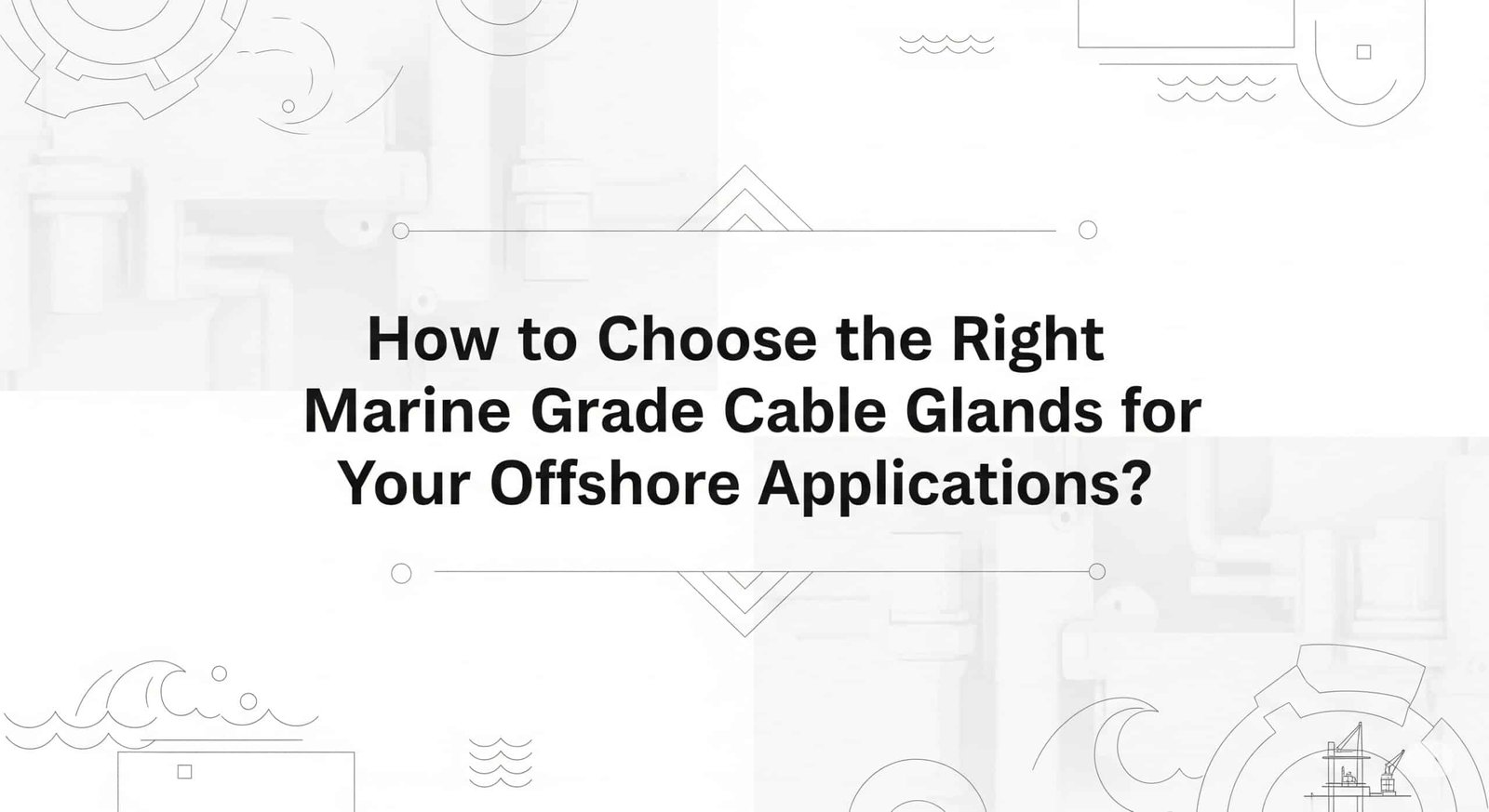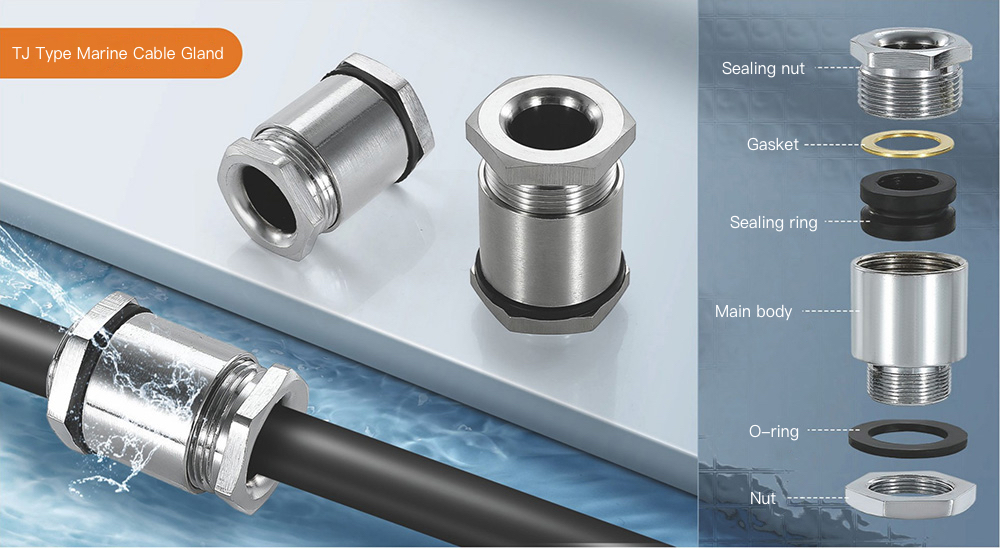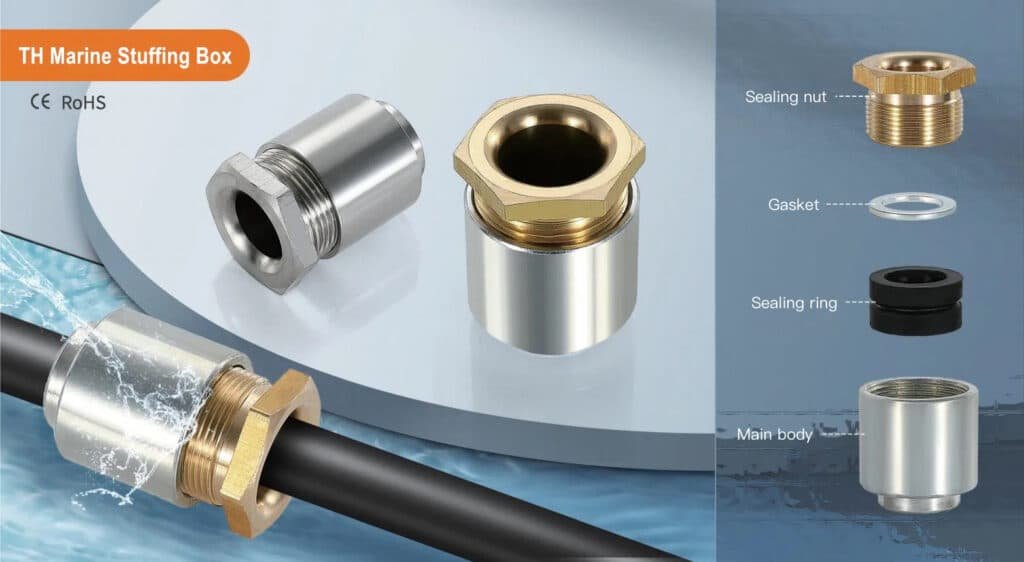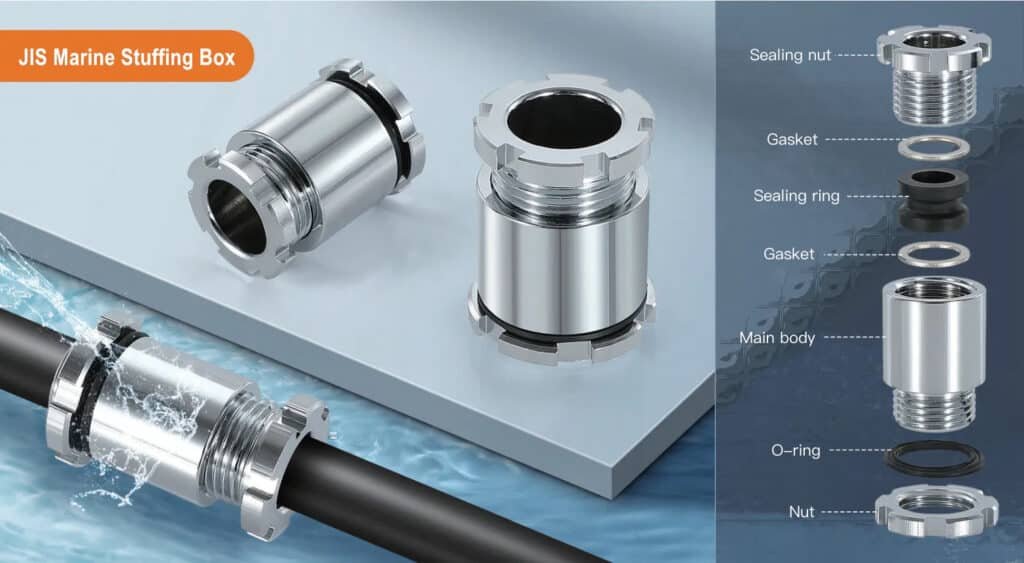Offshore environments are unforgiving. One failed cable connection can shut down your entire operation, costing thousands per hour in downtime.
Marine grade cable glands provide critical waterproof sealing and corrosion resistance for offshore electrical installations, ensuring reliable performance in harsh saltwater environments with IP68 protection and specialized materials.
Last month, I received an urgent call from Hassan, a platform manager in the North Sea. His standard cable glands had failed after just six months, causing a costly equipment shutdown. This story isn’t uncommon in marine applications.
Table of Contents
- What Makes Marine Cable Glands Different from Standard Ones?
- Which Materials Offer the Best Corrosion Resistance?
- How Do You Ensure Proper IP Rating for Underwater Applications?
- What Certifications Are Essential for Marine Installations?
What Makes Marine Cable Glands Different from Standard Ones?
Understanding these differences could save you from expensive failures and safety hazards offshore.
Marine cable glands feature enhanced sealing systems, corrosion-resistant materials like 316L stainless steel or marine-grade brass, and specialized gaskets designed to withstand saltwater, UV exposure, and extreme temperature variations.
Key Design Differences
Marine cable glands incorporate several critical features that standard glands lack:
| Feature | Standard Gland | Marine Grade Gland |
|---|---|---|
| Sealing System | Single O-ring | Multiple sealing barriers |
| Material | Standard brass/steel | 316L SS, marine brass |
| Gasket Type | NBR rubber | EPDM, Viton, or silicone |
| Thread Type | Standard metric | NPT or marine-specific |
| Testing Standards | IP65/IP66 | IP68, often IP69K |
Real-World Performance Impact
When David from a European offshore wind company contacted us, he was frustrated with frequent replacements. His previous supplier’s “marine” glands were actually just standard glands with basic coatings. After switching to our genuine marine-grade stainless steel glands with EPDM seals, his maintenance intervals extended from 6 months to over 3 years. 😉
Critical Environmental Factors
Marine environments present unique challenges:
- Salt spray corrosion1: Constant exposure to saltwater accelerates metal degradation
- UV radiation: Intense sunlight degrades polymer components
- Temperature cycling: Daily temperature swings cause expansion/contraction stress
- Vibration: Wave action and machinery create constant movement
- Pressure variations: Tidal changes and depth affect sealing performance
Which Materials Offer the Best Corrosion Resistance?
Material selection can make or break your marine installation’s longevity and safety.
316L stainless steel provides superior corrosion resistance for marine applications, while marine-grade brass (CuZn39Pb3) offers excellent conductivity. For extreme conditions, super duplex stainless steel or Inconel may be required.
Material Performance Comparison
Stainless Steel Options
316L Stainless Steel: Our most popular choice
– Excellent chloride resistance
– Low carbon content prevents carbide precipitation2
– Suitable for most offshore applications
– Cost-effective for long-term useSuper Duplex (2507): For extreme environments
– Superior pitting resistance3
– Higher strength than 316L
– Essential for subsea applications
– Higher initial cost but exceptional longevity
Brass Alternatives
- Marine Brass (CuZn39Pb3): Traditional choice
– Good corrosion resistance when properly treated
– Excellent electrical conductivity
– More economical than stainless steel
– Requires regular maintenance in harsh conditions
Coating Technologies
We’ve developed several protective coating options:
- Electroless nickel plating4: Uniform coverage, excellent corrosion protection
- Marine-grade powder coating: UV-resistant, impact-resistant finish
- Passivation treatments: Enhanced surface protection for stainless steel
Hassan’s refinery project required glands for a desalination plant intake. We recommended 316L stainless steel with electroless nickel plating. After two years of continuous submersion, the glands showed no signs of corrosion during their scheduled inspection.
How Do You Ensure Proper IP Rating for Underwater Applications?
Getting the IP rating wrong can lead to catastrophic equipment failure and safety hazards.
IP68 rating ensures complete protection against dust ingress and continuous submersion. For marine applications, verify the manufacturer’s specified depth and duration ratings, as IP68 standards can vary significantly between products.
Understanding IP Ratings for Marine Use
IP Rating Breakdown
- First digit (6): Complete dust protection
- Second digit (8): Protection against continuous submersion
Critical Specifications to Verify
When evaluating IP68 glands, always ask for:
- Maximum depth rating: How deep can it go?
- Duration rating: How long can it stay submerged?
- Pressure rating: What pressure can it withstand?
- Temperature range: Operating limits in your environment
Testing and Verification
At Bepto, we conduct rigorous testing beyond standard requirements:
| Test Type | Our Standard | Industry Minimum |
|---|---|---|
| Submersion depth | 10 meters | 1 meter |
| Duration | 168 hours | 30 minutes |
| Salt spray | 1000 hours | 96 hours |
| Temperature cycling | -40°C to +120°C | -20°C to +80°C |
Sealing System Design
Our marine glands use a multi-barrier sealing approach:
- Primary seal: High-performance elastomer O-ring
- Secondary seal: Backup sealing element
- Thread sealant: Marine-grade compound
- Strain relief: Prevents seal damage from cable movement
David’s wind farm project required glands rated for 5-meter submersion during storm surges. Our IP68 glands with 10-meter rating provided the safety margin his insurance company demanded.
What Certifications Are Essential for Marine Installations?
Missing critical certifications can halt your project and create liability issues.
Essential marine certifications include DNV GL for offshore applications, Lloyd’s Register for marine vessels, ABS for drilling platforms, and regional approvals like ATEX for explosive atmospheres. Always verify certification scope matches your specific application.
Critical Certification Bodies
International Marine Standards
DNV GL (Det Norske Veritas)5: Global offshore standard
– Covers fixed and floating platforms
– Rigorous material and design requirements
– Mandatory for North Sea operationsLloyd’s Register: Marine vessel certification
– Ship and offshore vessel applications
– Comprehensive testing protocols
– Required for commercial shippingABS (American Bureau of Shipping): US offshore standard
– Gulf of Mexico operations
– Drilling platform requirements
– Mobile offshore drilling units (MODUs)
Regional Requirements
- ATEX (Europe): Explosive atmosphere protection
- IECEx (International): Global explosive atmosphere standard
- CSA (Canada): Canadian offshore requirements
- JIS (Japan): Japanese marine standards
Certification Verification Process
When Hassan needed glands for his Middle East refinery’s marine loading terminal, we provided:
- Complete certification packages
- Third-party test reports
- Material traceability documents
- Installation guidelines
Documentation Requirements
Essential documentation includes:
- Certificate of Conformity: Proves compliance with standards
- Material certificates: Chemical composition and mechanical properties
- Test reports: Actual performance data
- Installation instructions: Proper mounting procedures
- Maintenance schedules: Recommended service intervals
Common Certification Pitfalls
I’ve seen projects delayed because of:
- Scope mismatch: Certification doesn’t cover specific application
- Expired certificates: Documents not current
- Regional variations: Wrong standard for project location
- Incomplete documentation: Missing supporting test data
Conclusion
Selecting the right marine cable glands requires careful consideration of materials, IP ratings, and certifications to ensure reliable offshore performance.
FAQs About Marine Cable Glands
Q: What’s the difference between IP67 and IP68 for marine applications?
A: IP68 provides protection against continuous submersion while IP67 only protects against temporary immersion up to 1 meter for 30 minutes. Marine applications always require IP68 minimum.
Q: How often should marine cable glands be inspected?
A: Inspect every 6 months for critical applications, annually for general use. Check for corrosion, seal integrity, and proper torque values during each inspection.
Q: Can I use standard cable glands with marine coatings instead of marine-grade glands?
A: No. Marine environments require specialized materials and sealing systems. Coated standard glands will fail prematurely and may not meet safety certifications.
Q: What’s the typical lifespan of marine cable glands?
A: Quality marine glands should last 10-15 years with proper maintenance. Factors affecting lifespan include material selection, installation quality, and environmental severity.
Q: Do I need different glands for above-water vs. underwater applications?
A: Yes. Underwater applications require higher IP ratings, specialized materials, and often additional certifications. Consult with your supplier about specific depth and duration requirements.
-
Learn about the electrochemical process of saltwater corrosion and the standards for salt spray testing. ↩
-
Understand the metallurgical phenomenon of carbide precipitation and how it affects the corrosion resistance of stainless steel. ↩
-
Explore what pitting corrosion is and how the Pitting Resistance Equivalent Number (PREN) is calculated. ↩
-
Discover the process of electroless nickel plating (ENP) and its benefits for corrosion and wear resistance. ↩
-
Visit the official DNV website to learn about their classification and certification services for the maritime industry. ↩





